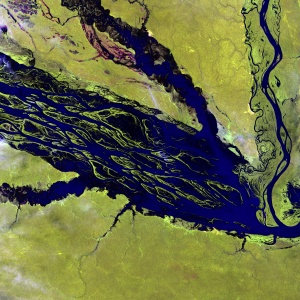
The Amazonian dark earth (terra preta) is not only incredibly fertile but is also a substantial carbon sink. However, whether or not this soil was formed intentionally through indigenous land practice has long been unclear. This paper uses soil analysis and ethnographic observation to demonstrate similarities between ancient and modern dark earth formation by indigenous communities, and to quantify the benefits these practices could have for soil fertility and carbon sequestration.
Summary
The occurrence of substantial areas of dark earth in many archaeological sites in the Amazon, combined with recent discoveries that the Amazon was a centre of crop domestication suggests that populations deliberately enriched soils to overcome the low fertility of weathered rainforest soil. Despite being centuries old, these soils are still sought after today for their fertility and are thought to be stable carbon sinks. Current hypotheses suggest that the soils are either the result of (intentional or unintentional) household waste disposal or cultivation practices. Both originate from the observation that dark earth is abundant in charcoal, artefacts and high organic matter. In order to determine the origins of the soils, as well as assess their fertility and the density and stability of carbon they hold, this paper combines soil analysis and ethnographic observation of the Kuikuro Indigenous Territory in the Upper Xingu River basin with two archaeological sites in the territory and one sample of background soil in the area between the sites.
Soil samples demonstrated that dark earth in current and archaeological sites contained similar spatial distribution and nutrient compositions, as well as higher nutrient content and significantly more soil organic carbon than surrounding areas. The most enriched soils in the centre of sites was more than twice as high in soil organic carbon than the perimeter of the transect. Elements associated with human soil amendment (P, K, Ca, Mg, Mn, and Zn) were also 10-fold higher in the centre of the sites. The periphery of the site contained levels of soil organic carbon similar to the background sample (containing between 6 and 10 kg/m2 in the upper 1m), whilst the dark earth deposits featured soil organic carbon of up to 22kg/m2. These highest readings contain as much carbon as the above-ground biomass of the amazon rainforest. Through subtracting the baseline levels of carbon, the authors estimate that dark earth soils are enriched by between 2 and 12 kg/m2 for the archaeological sites and 5kg/m2 in the current village. The measurements show that carbon in dark earth persists for centuries, demonstrating the enormous carbon and nutrient storage of anthropogenic dark earth and the potential of these practices for further carbon sequestration through continued formation. However, the stability of this carbon is significantly threatened by land-use change and climate warming, with deforested agricultural sites containing much lower nutrient and carbon content in comparison to other sites.
Through ethnographic observations in the Kuikuro II village, the research determined that the dark earth is intentionally created through land management practices for crop cultivation purposes. Nutrient rich waste from fishing and manioc (cassava) farming is deposited in waste heaps 60 cm above the surface near to settlements. Organic refuse, particularly ash and charcoal, is often spread on these sites. After a few years, dark earth begins to form in these areas, which residents exploit for planting nutrient-demanding crops. One resident described “Charcoal and ash we sweep, gather it up and then throw it where we will plant, to turn into beautiful eegepe. There we can plant sweet potatoes. When you plant where there is no eegepe, the soil is weak. That is why we throw the ash, manioc peelings, and manioc pulp”.
Combining these ethnographic observations with the similarities in composition and spatial distribution of soil data in ancient and modern dark earth deposits, the researchers conclude that ancient peoples created dark earth deposits through intentional soil management. This conclusion lends weight to the idea that managing soil to increase organic carbon content and incorporating charcoal could be one of the most effective and readily available means to remove excess carbon from the atmosphere. Modern sustainable agriculture and climate change mitigation efforts, inspired by the persistent fertility of ancient dark earth, can draw on these traditional methods practised to this day by Indigenous Amazonians.
Abstract
Fertile soil known as Amazonian dark earth is central to the debate over the size and ecological impact of ancient human populations in the Amazon. Dark earth is typically associated with human occupation, but it is uncertain whether it was created intentionally. Dark earth may also be a substantial carbon sink, but its spatial extent and carbon inventory are unknown. We demonstrate spatial and compositional similarities between ancient and modern dark earth and document modern Indigenous practices that enrich soil, which we use to propose a model for the formation of ancient dark earth. This comparison suggests that ancient Amazonians managed soil to improve fertility and increase crop productivity. These practices also sequestered and stored carbon in the soil for centuries, and we show that some ancient sites contain as much carbon as the above-ground rainforest biomass. Our results demonstrate the intentional creation of dark earth and highlight the value of Indigenous knowledge for sustainable rainforest management.
Reference
Schmidt, M.J., Goldberg, S.L., Heckenberger, M., Fausto, C., Franchetto, B., Watling, J., Lima, H., Moraes, B., Dorshow, W.B., Toney, J. and Kuikuro, Y., 2023. Intentional creation of carbon-rich dark earth soils in the Amazon. Science Advances, 9(38), p.eadh8499.
Read the full article here and for more on agriculture in the amazon read our soy explainer







Post a new comment »